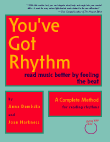
American String Teacher
February 2001 | Volume 51 | Number 1
Reviews
Books & Music
This three-volume set, designed as a stand-alone series or companion to instrumental or vocal instruction, has as its basic premise that a musician must learn to feel the beat. It uses a systematic technique designed to teach musicians how to internalize or feel the beat employing such techniques as spoken-word exercises and clapping patterns. The spoken exercises are actually complicated and require a student who can already read at least at a third grade level; the authors suggest ages nine to adult.
Dembska and Harkness present a thorough introduction that explains how meter is used as the rhythmic ordering of music. Their approach is a marked departure from many available instrumental instructional methods, which are designed to impart instrumental technique, therefore spending relatively little time on rhythm. The conceptual information is similar to such approaches as eurhythmics and HindemithÕs Elementary Training for Musicians, but these volumes are clearly intended for today's younger people and are useful to instructors who have not been formally trained in eurhythmics or movement.
The organization of topics, from basic to advanced, is well presented. Volume 1, appropriate for the first two years of instruction, deals primarily with establishing the concept of simple meters (2/4, 3/4, 4/4, and 2/2), metric accents, pickup notes, repeats, ties, notational symbols, and basic syncopation. Volumes 2 and 3 expand on the basics, presenting topics such as compound meter, hemiola, and mixed meters. Both children and adults will find the activities are enjoyable, helpful, and interesting. The spoken-word compositions are fresh (some based on historical or contemporary themes) and occasionally quite challenging. In addition, each volume has supplemental information— on American music, including biographical sketches of composers, a glossary of terms, and bibliographies of print publications and recordings. Overall this series is well done and would be useful to anyone concerned about developing rhythmically literate musicians, whether in private or group instruction.
— Kathleen A. Horveth
Kathleen A. Horveth, assistant professor of music education at the University of Illinois, has been a frequent clinician in many areas of the eastern and midwestern United States. The author of many articles, she is an active performer on double bass who has taught in public schools in four states.
